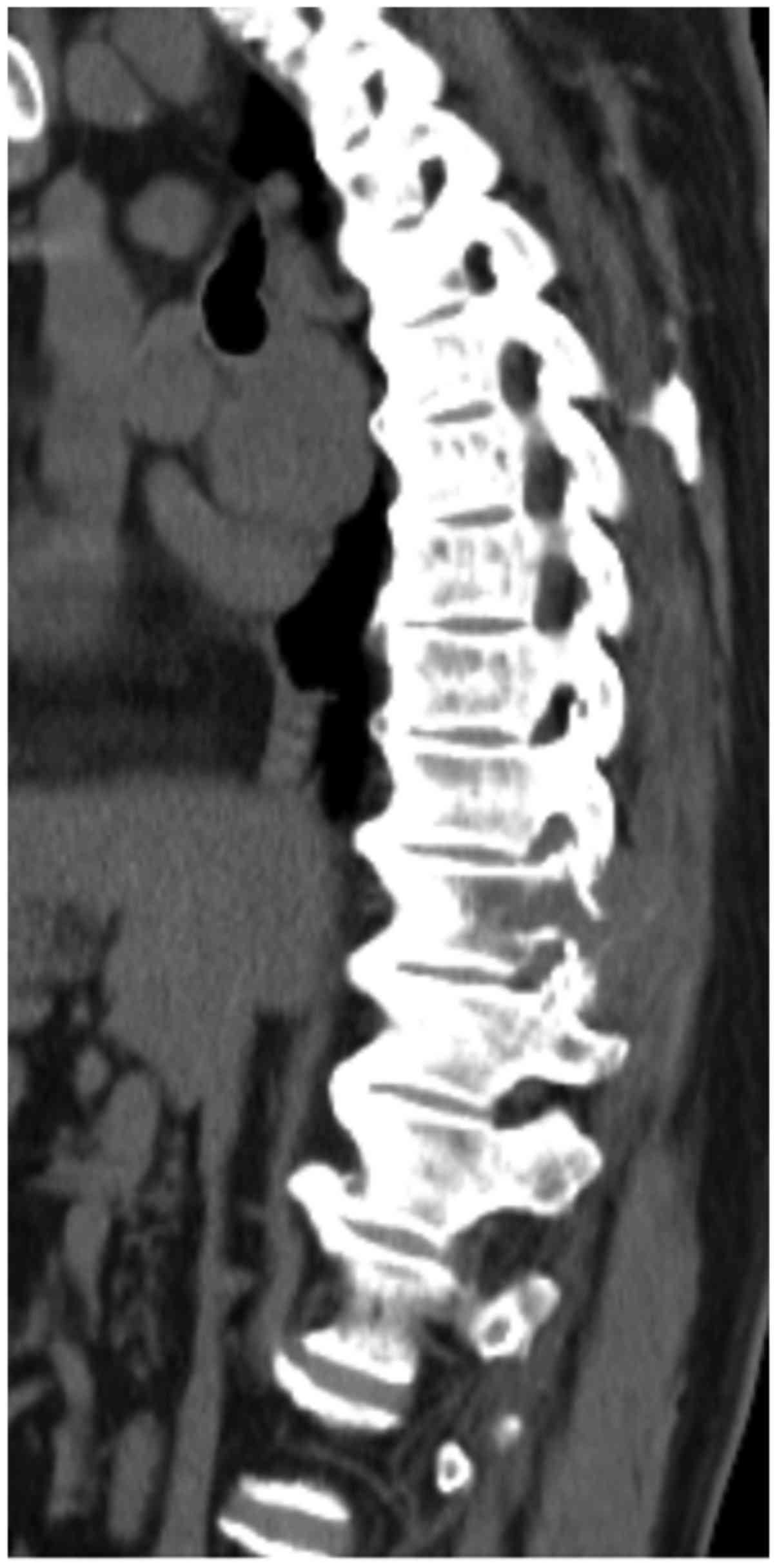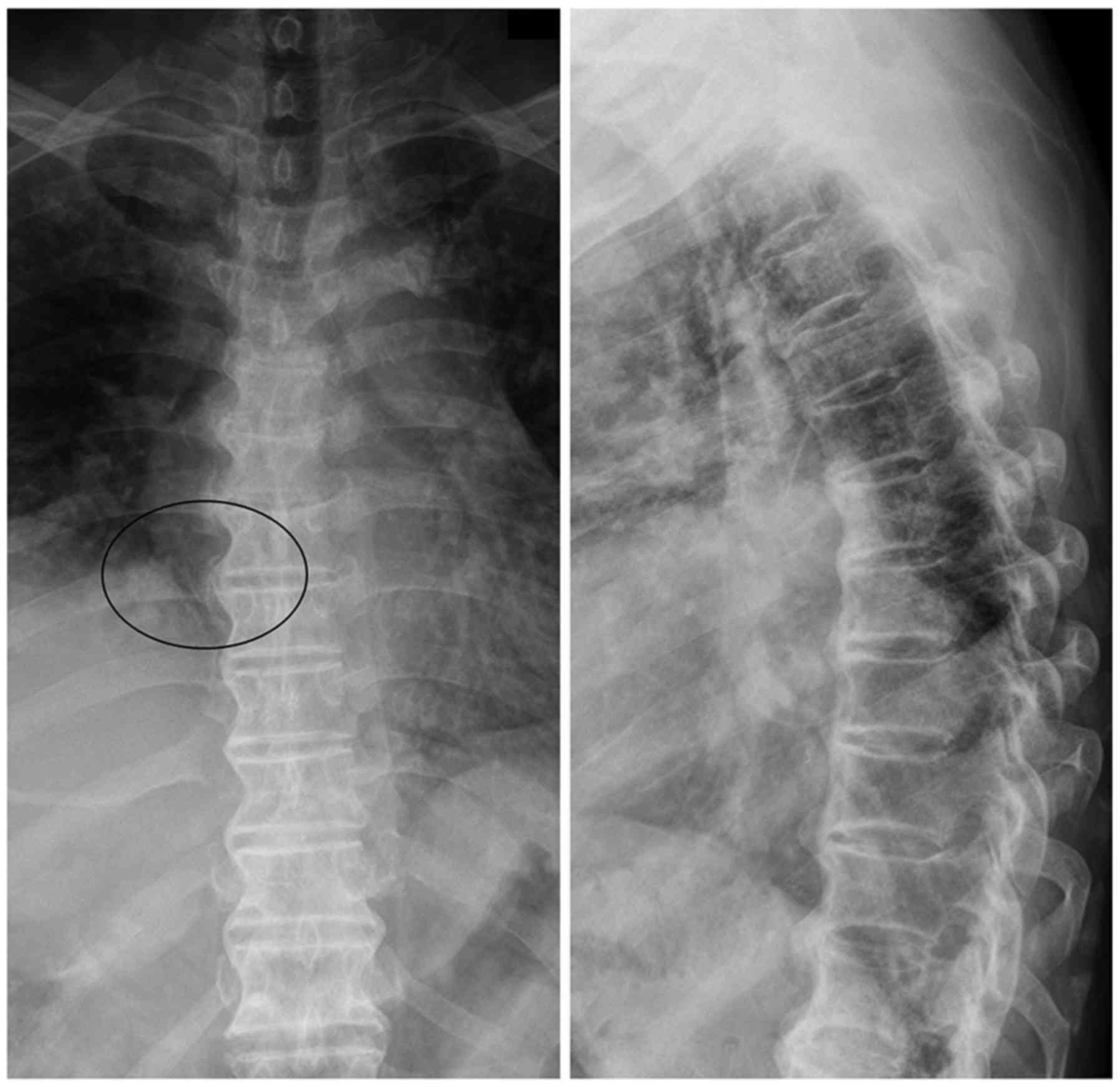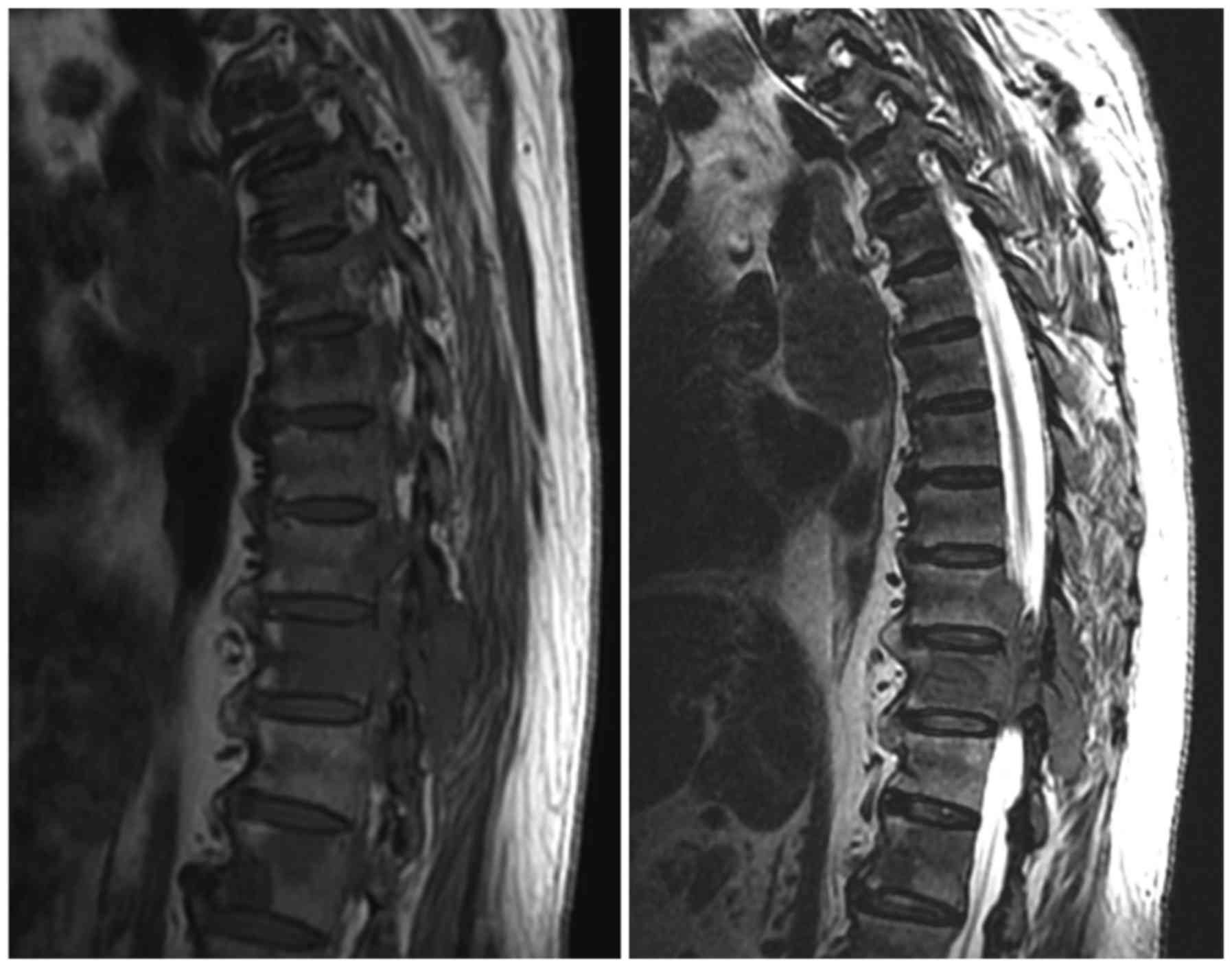|
1
|
Guzik G: Current incidence of different
morphological types of malignant metastases to the spine based on
magnetic resonance imaging. Ortop Traumatol Rehabil. 19:137–144.
2017. View Article : Google Scholar : PubMed/NCBI
|
|
2
|
Gupta PK, Misra S, Verma R, Soni N, Lamin
JC, Mishra RK, Behari S and Kumar S: Primary intradural cervical
spine melanocytoma: A rare tumor and review of literature. Neurol
India. 65:653–657. 2017. View Article : Google Scholar : PubMed/NCBI
|
|
3
|
Yang P, Lin J, Liu H, Shen H and Yang HL:
Primary bone mantle cell lymphomas with multiple vertebral
compression fractures: A case report. Oncol Lett. 13:1288–1292.
2017. View Article : Google Scholar : PubMed/NCBI
|
|
4
|
Konovalov NA, Nazarenko AG, Asyutin DS,
Onoprienko RA, Korolishin VA, Cherkiev IU, Martynova MA, Zakirov
BA, Timonin SY and Kosyr'kova AV: The use of intraoperative
neuroimaging tools and a navigation system in surgical treatment of
primary and metastatic tumors of the spine. Vopr Neirokhir.
80:5–14. 2016.(In Russian). View Article : Google Scholar
|
|
5
|
Zhou Z, Wang X, Wu Z, Huang W and Xiao J:
Epidemiological characteristics of primary spinal osseous tumors in
Eastern China. World J Surg Oncol. 15:732017. View Article : Google Scholar : PubMed/NCBI
|
|
6
|
Tomasian A, Wallace A, Northrup B, Hillen
TJ and Jennings JW: Spine cryoablation: Pain palliation and local
tumor control for vertebral metastases. AJNR Am J Neuroradiol.
37:189–195. 2016. View Article : Google Scholar : PubMed/NCBI
|
|
7
|
Welte SE, Wiskemann J,
Scharhag-Rosenberger F, Förster R, Bostel T, Bruckner T, Schlampp
I, Meyerhof E, Sprave T, Nicolay NH, et al: Differentiated
resistance training of the paravertebral muscles in patients with
unstable spinal bone metastasis under concomitant radiotherapy:
Study protocol for a randomized pilot trial. Trials. 18:1552017.
View Article : Google Scholar : PubMed/NCBI
|
|
8
|
Sciubba DM, De la Garza Ramos R, Goodwin
CR, Xu R, Bydon A, Witham TF, Gokaslan ZL and Wolinsky JP: Total en
bloc spondylectomy for locally aggressive and primary malignant
tumors of the lumbar spine. Eur Spine J. 25:4080–4087. 2016.
View Article : Google Scholar : PubMed/NCBI
|
|
9
|
Boriani S, Gasbarrini A, Bandiera S,
Ghermandi R and Lador R: Predictors for surgical complications of
en bloc resections in the spine: Review of 220 cases treated by the
same team. Eur Spine J. 25:3932–3941. 2016. View Article : Google Scholar : PubMed/NCBI
|
|
10
|
Kumar N, Zaw AS, Khoo BL, Nandi S, Lai Z,
Singh G, Lim CT and Thiery JP: Intraoperative cell salvage in
metastatic spine tumour surgery reduces potential for reinfusion of
viable cancer cells. Eur Spine J. 25:4008–4015. 2016. View Article : Google Scholar : PubMed/NCBI
|
|
11
|
Tamam MÖ, Tamam C, Yıldırım D, Mülazımoğlu
M and Kamalı G: Intramedullary spinal cord metastasis from
malignant mesenchymal tumor: Detection with FDG-PET/CT. Mol Imaging
Radionucl Ther. 24 Suppl 1:22–24. 2015. View Article : Google Scholar
|
|
12
|
Monserrate A, Zussman B, Ozpinar A,
Niranjan A, Flickinger JC and Gerszten PC: Stereotactic
radiosurgery for intradural spine tumors using cone-beam CT image
guidance. Neurosurg Focus. 42:E112017. View Article : Google Scholar : PubMed/NCBI
|
|
13
|
Klinaki I, Al-Nahhas A, Soneji N and Win
Z: 68Ga DOTATATE PET/CT uptake in spinal lesions and MRI
correlation on a patient with neuroendocrine tumor: Potential
pitfalls. Clin Nucl Med. 38:e449–e453. 2013. View Article : Google Scholar : PubMed/NCBI
|
|
14
|
Kobayashi K, Imagama S, Ando K, Hida T,
Ito K, Tsushima M, Ishikawa Y, Matsumoto A, Morozumi M, Tanaka S,
et al: Contrast MRI findings for spinal schwannoma as predictors of
tumor proliferation and motor status. Spine. 42:E150–E155. 2017.
View Article : Google Scholar : PubMed/NCBI
|
|
15
|
Mechl M, Šprláková-Puková A and Keřkovský
M: CT and MRI of spinal tumors - Review and differential diagnosis
of most common abnormalities. Cesk Radiol. 66:369–378. 2012.
|
|
16
|
Tarnoki DL, Tarnoki AD, Ohlmann-Knafo S
and Pickuth D: Pattern of tumour spread of common primary tumours
as seen on magnetic resonance imaging. Pathol Oncol Res. 22:79–85.
2016. View Article : Google Scholar : PubMed/NCBI
|
|
17
|
Chou CT, Chen RC, Lin WC, Ko CJ, Chen CB
and Chen YL: Prediction of microvascular invasion of hepatocellular
carcinoma: Preoperative CT and histopathologic correlation. AJR Am
J Roentgenol. 203:W253–W259. 2014. View Article : Google Scholar : PubMed/NCBI
|
|
18
|
Sahinarslan A, Erbas G, Kocaman SA, Bas D,
Akyel A, Karaer D, Ergun MA, Arac M and Boyaci B: Comparison of
radiation-induced damage between CT angiography and conventional
coronary angiography. Acta Cardiol. 68:291–297. 2013. View Article : Google Scholar : PubMed/NCBI
|
|
19
|
Ganten MK, Schuessler M, Bäuerle T,
Muenter M, Schlemmer HP, Jensen A, Brand K, Dueck M, Dinkel J,
Kopp-Schneider A, et al: The role of perfusion effects in
monitoring of chemoradiotherapy of rectal carcinoma using
diffusion-weighted imaging. Cancer Imaging. 13:548–556. 2013.
View Article : Google Scholar : PubMed/NCBI
|
|
20
|
D'Andrea K, Dreyer J and Fahim DK: Utility
of preoperative magnetic resonance imaging coregistered with
intraoperative computed tomographic scan for the resection of
complex tumors of the spine. World Neurosurg. 84:1804–1815. 2015.
View Article : Google Scholar : PubMed/NCBI
|












